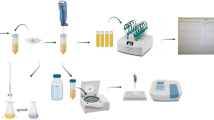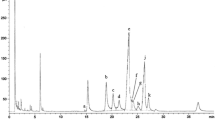Abstract
A comparison of iodine values showed that the degree of saturation of tea seed oil (Lahjan variety) was intermediate between the oils of sunflowerseed (Fars variety) and olive (Gilezeytoon variety), and the saponification values of these three oils were similar. Tea seed oil consisted of 56% oleic acid (C18∶1), 22% linoleic acid (C18∶2), 0.3% linolenic acid (C18∶3), and therefore, on the basis of oleic acid, occupied a place between sunflower and olive oil. In studies at 63°C, the shelf life of tea seed oil was higher than that of sunflower oil and similar to olive oil. Tea seed oil was found to have a natural antioxidant effect, and it enhanced the shelf life of sunflower oil at a 5% level. In this study, tea seed oil was found to be a stable oil, to have suitable nutritional properties (high-oleic, medium-linoleic, and lowlinolenic acid contents), and to be useful in human foods.
Similar content being viewed by others
References
Ravichandran, R., and M. Dhandapani, Composition, Characteristics and Potential Uses of South Indian Tea Seeds, J. Food Sci. Technol. 29:394–396 (1992).
Sengupta, C., A. Sengupta, and A. Ghosh, Triglyceride Composition of Tea Seed Oil, J. Sci. Food Agric. 27:1115–1122 (1976).
Tang, L., E. Bayer, and R. Zhuang, Production, Properties and Use of Chinese Tea Seed Oil, Fett Wissenschaft Technol. 95:23–27 (1993).
Tokue, C., E. Kataoka, and W. Tanimura, Characterization of Lipids in Tea Seed Cultivated in Taiwan and Japan, J. Jpn. Soc. Nutr. Food Sci. 42:71–77 (1989).
Singh, I.D., Tea Variety Development and Management in Iran, Food and Agriculture Organization, Rome, TCP/IRA/6614, 1998, 185 pp.
Egan, H., R.S. Kirk, and R. Sawyer, Pearson’s Chemical Analysis of Foods, 8th edn., Longman, Harlow, Essex, United Kingdom, 1987.
Tindale, L.H., and S.R. Hill-Haas, Current Equipment for Mechanical Oil Extraction, J. Am. Oil Chem. Soc. 53:265–270 (1976).
Hicks, C.R., and K.V. Turner, Fundamental Concepts in the Design of Experiments, 5th edn., Oxford University, Oxford, 1999.
Steel, R.G.D., J.H. Torrie, and D.A. Dickey, Principles and Procedure of Statistics: A Biometrical Approach, McGraw Hill, New York, 1997.
Yandell, B.S., Practical Data Analysis for Designed Experiments, Chapman & Hall, London, 1997.
Weihrauch, J.L., and B.B. Teter, Fruit and Vegetable By-products as Sources of Oil, in Technological Advances in Improved and Alternative Sources of Lipids, edited by B. Kamel and Y. Kakuda, Chapman & Hall, Glasgow, United Kingdom, 1994, pp. 177–208.
Belitz, H.D., and W. Grosch, Food Chemistry, 2nd edn. (translated from the 5th German edn. by M.M. Burghagen, D. Hadziyev, P. Hessel, S. Jordan, and C. Sprinz), Springer, Berlin, 1999, pp. 602–630.
Ravichandran, R., Fat Stability and Amino Acids in South Indian Tea Seeds, Int. J. Food Sci. Technol. 28:639–646 (1993).
Owuor, P., A. Chavanji, and R.M. Munavu, Chemical Studies of the Kenyan Tea Seeds. I, Physical and Chemical Characteristics of the Kernel Oil, Tea 6:23–28 (1985).
Rah, H.H., S.O. Baik, and S.B. Han, Chemical Composition of the Seed of the Korean Green Tea Plant (Camellia sinensis L.), J. Kor. Agric. Chem. Soc. 35:272–275 (1992).
Yazicioglu, T., A. Karaali, and J. Goekcen, Turkish Tea Oil and Tea Saponin, Fett Seifen Anstrichm. 79:115–120 (1997).
Hodgson, A.S., Refining and Bleaching, in Bailey’s Industrial Oil and Fat Products, 5th edn., edited by Y.J. Hui, John Wiley & Sons, New York, 1996, Vol. 4, pp. 157–212.
Silkeberg, A., and S.P. Kochhar, Refining of Edible Oil Retaining Maximum Antioxidative Potency, U.S. Patent 6,033, 706 (2000).
Salunke, D.K., J.K. Chavan, R.N. Adsule, and S.S. Kadam, World Oilseeds, Van Nostrand Reinhold, New York, 1992, pp. 87–248.
Author information
Authors and Affiliations
Corresponding author
About this article
Cite this article
Sahari, M.A., Ataii, D. & Hamedi, M. Characteristics of tea seed oil in comparison with sunflower and olive oils and its effect as a natural antioxidant. J Amer Oil Chem Soc 81, 585–588 (2004). https://doi.org/10.1007/s11746-006-0945-0
Received:
Accepted:
Issue Date:
DOI: https://doi.org/10.1007/s11746-006-0945-0




